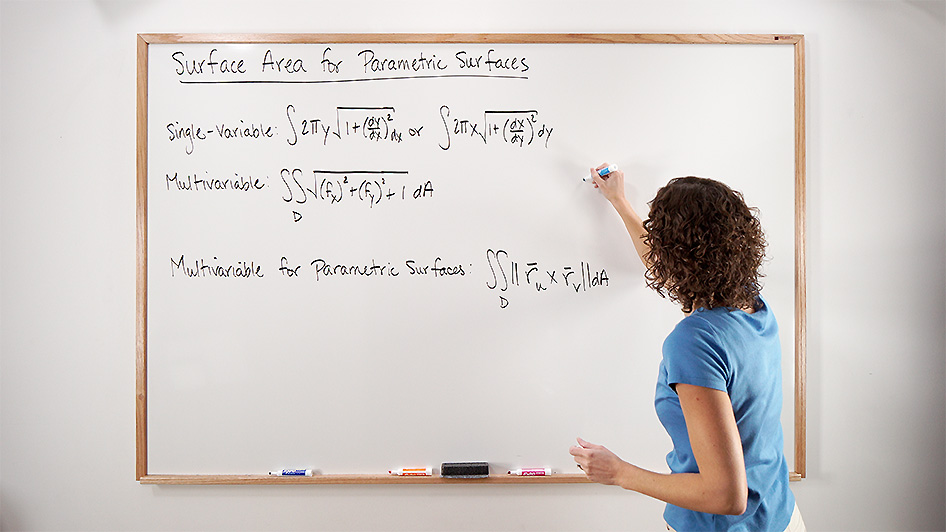How do you parameterize a surface?

Jenn, Founder Calcworkshop®, 15+ Years Experience (Licensed & Certified Teacher)
This is the big question we need to answer in order to calculate surface integrals and eventually flux integrals, Stoke’s theorem, and divergence theorem in our quest for understanding vector calculus.
In fact, this lesson is all about finding parametric surfaces and their areas.
So, let’s get to it.
Parameterization
First, we need to begin with finding a parametric representation for a surface.
Why?
Because relating a surface to a subset of a plane makes things easier to calculate, and parameterization is the tool we need to accomplish this goal.
Parametric Curve Vs. Surface
Okay, so from our previous studies of parametric equations, we know that a curve is a one-dimensional object represented by three parametric equations involving one parameter.
Whereas a surface is a two-dimensional object that can be represented by three vector equations using two parameters.
So, a parameterization is a function defined on a region
where
And a parametric surface is the image of a region
Example
Great. So, let’s put this knowledge to use with a few problems.
Problem #1 – Find the parametric equations for the surface
One way to parameterize the surface is to take
and as parameters and writing the parametric equation as and such that the parameterizations for this paraboloid is:
But parameterizations are not unique, as we can also represent this surface using polar coordinates.
If we let
and then the paraboloid has the following parametric representation
Problem #2 Find the parametric representation for
First, we must notice that we are being asked to parameterize a sphere. Therefore, we now need to ask ourselves, what coordinate system best represents a sphere?
Spherical coordinates, of course!
So, we will use the following parametric equations:
and such that the parameterizations for this sphere where is:
Easy, right?
And in our lesson, we will look at how to find the parametric representation for a surface, visualize and determine the surface given the parametric representation using the following coordinates:
- Cartesian
- Polar
- Cylindrical
- Spherical
Tangent Planes
Okay, so now that we know how to define parametric surfaces, it’s time to turn our attention to learning how to find the tangent plane to a parametric surface at a point.
Now, we’ve already seen how to find tangent planes to a level surface of a function using the gradient vector. But now, we will learn how to find tangent planes to parametric surfaces.
Consider a parametric surface
Well, all we have to do is find a point through the plane and the normal vector.
We already know our point,
It is important to know that if
Example
Let’s look at an example.
Find the tangent plane to the unit sphere
First, we need parameterize our unit sphere with:
knowing that
Okay, now that we have our parameterization, we need to take our first order partial derivatives with respect to
and .
Now we need to find
and from our given point by solving our parametric equations:
Now, we’re ready to evaluate our partials knowing that
and .
Next, we will calculate the normal vector to the tangent plane.
Now, recall the formula for writing an equation of the tangent plane with point
and normal vector is . Therefore, an equation of the tangent plane at
is:
Pretty straightforward, right?
Surface Area Of Parametric Surfaces
But there’s more!
We can extend our parameterization skills to find the surface area of parametric surfaces using double integrals.
If a smooth parametric surface
where
Example
Let’s prove why this formula works.
Well, if we take our function
and parameterize it so that by letting and Then,
And
Thus,
Which is exactly the same formula we learned about in our previous lesson on surface area of the graph of a function
:
Super cool!
Together we will learn how to identify and visualize the surface of a given vector equation, find a parametric representation for a surface, find equations of tangent planes to a parametric surface at a point and even find the surface area.
Gosh, there is a lot of information to cover and discuss in this lesson so let’s get after it!
Video Tutorial w/ Full Lesson & Detailed Examples (Video)

Get access to all the courses and over 450 HD videos with your subscription
Monthly and Yearly Plans Available
Still wondering if CalcWorkshop is right for you?
Take a Tour and find out how a membership can take the struggle out of learning math.